
Strategic-Tactical Leadership
Index™ (STLI)
[Your Name]
Welcome, and thank you for your valued participation in this Strategic-Tactical Leadership Index™ Survey. The purpose of this survey is for you to gain candid and specific information about your leadership effectiveness. Your feedback will be used to provide insight into your interpersonal strengths as well as potential areas for improvement.
This is a valuable and enlightening process for even the most successful professional. Thank you again for your participation.
About the Competencies: Your feedback is requested in nine categories. Please read each description, and circle the rating you believe best describes your colleague. Additionally, please provide comments for each section that present a picture of specific behaviors your colleague exhibits and your reactions to these behaviors.
1. Critical thinking
2. Decision making
3. Strategic thinking
4. Emotional leadership
5. Communication skills
6. Talent leadership
7. Team leadership
8. Change leadership
9. Drive for results
JohnMattonePartners, Inc.
407-268-5593
Use the rating scale below to rate your colleague’s effectiveness in each category. If you are using the STLI as a self-assessment, simply rate your own effectiveness.
| Description | Rating |
| Ineffective: Demonstrates incorrect behavior in this area or does not demonstrate this behavior at all. | 1 |
| Somewhat effective: Demonstrates this behavior inconsistently and with minimal success. | 2 |
| Effective: Demonstrates this behavior with consistency and regular success. | 3 |
| Very effective: Demonstrates this behavior with extreme consistency and with extraordinary success. | 4 |
| Most effective: Among the best of the best in this area. A model for others. | 5 |
| Does not apply to colleague. | N/A |
My colleague is motivated by:

| 1. | Improving the lives of others. |
| Comments: John is often seen and heard making rude comments about our customers. One customer actually overheard John say how annoying it was to take care of the customers and that customer left our business promising to tell everyone she knew not to visit our organization again. |
My colleague is motivated by:

| 2. | Improving the lives of others. |
| Comments: Maria is completely dedicated to improving the lives of others. I have seen her on numerous occasions put aside her personal desires to meet the needs of others. I once heard a customer say that Maria spent three hours waiting with her after the offices were closed to go over her personal legal documents at no extra charge. |
My colleague:
1. Recognizes the important assumptions that underlie their own position as well as the positions advanced by others.
2. Analyzes information and positions advanced by others objectively and accurately.
3. Questions the validity of supporting evidence and understands how emotion can influence the situation.
4. Able to bring diverse information together that logically follows from the available evidence.
5. Able to avoid overgeneralizing to other situations based on available evidence.
6. Raises vital questions, formulating them clearly and precisely.
7. Comes to well-reasoned conclusions and solutions, testing them against relevant standards.
8. Ability to adjust their own position based on relevant information and data.
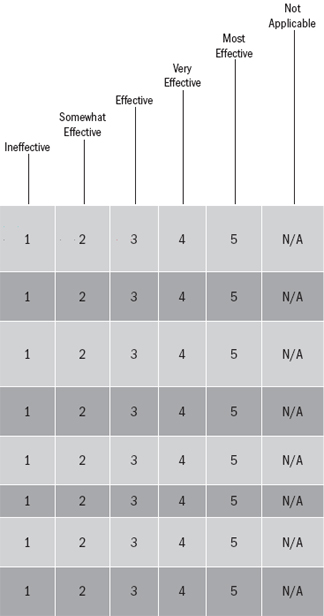
Please provide frank and specific feedback concerning this individual’s observable behaviors and your reactions to those behaviors.
Comments:
My colleague:
9. Collects, analyzes, and utilizes accurate data from multiple relevant sources (i.e., Head).
10. Objectively assesses the impact of alternative decision scenarios based on the accurate data collected.
11. Makes decisions that are accepted by a wide audience and are aligned with the core values of the organization (i.e., Heart).
12. Has a trustworthy “Gut” and instinctively knows the right course of action and effectively removes obstacles that might impede its implementation.
13. Possesses clear access to “Head,” “Heart,” and “Gut” so the decisions stands the test of time and scrutiny.
14. Understands and respects the organization’s expectations regarding how decisions are made and executed.
15. Understands and utilizes the decision-making lines of authority as well as delegates decision making when and where it is appropriate.
16. Effectively balances the situations and many factors–for example, time, risk, and strategic priorities–into the final decision.
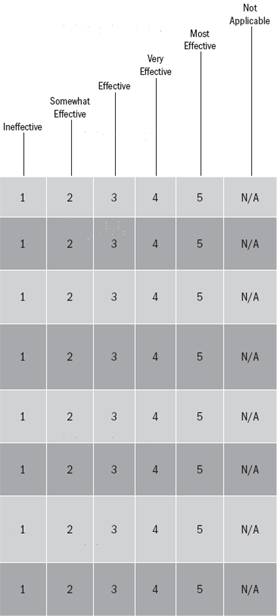
Please provide frank and specific feedback concerning this individual’s observable behaviors and your reactions to those behaviors.
Comments:
My colleague:
17. Knows the business environment (e.g., industry trends, market conditions, competition, expectations and needs of customers, etc.).
18. Knows the organization (e.g., structure, systems, people, products, services, technologies, financial picture, strengths and weaknesses, etc.) as a foundation for creating and communicating a compelling future.
19. Develops a values-based, inspiring, and realistic vision that engages others.
20. Defines a viable mission for the unit based on organization’s vision, the relevant strengths and limitations of the organization/unit, as well as the current and future needs of the customer base.
21. Is personally aligned and connected to the strategic mission of the organization.
22. Creatively crafts strategies that are aligned with important market conditions, vision of the organization, the systems and structure, and the available talent that exists.
23. Effectively translates strategies into goals that are specific, measureable, achievable, realistic, and time limited.
24. Uses a measurement philosophy and approach to ensure that goals are accomplished.
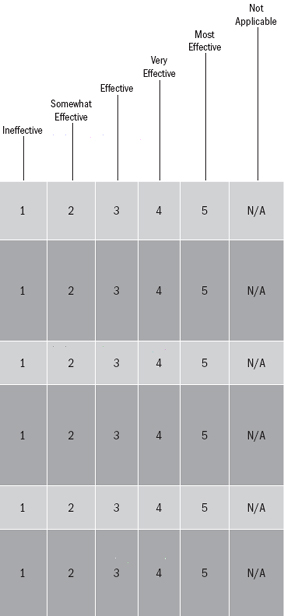
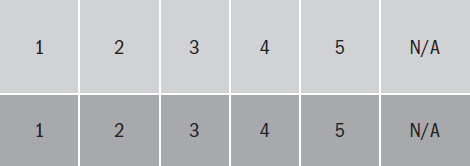
Please provide frank and specific feedback concerning this individual’s observable behaviors and your reactions to those behaviors.
Comments:
My colleague:
25. Demonstrates a strong self-awareness.
26. Demonstrates a strong self-concept and character as a foundation for effectively working through challenges.
27. Demonstrates the ability to use positive thinking and emotions as a foundation for working through challenges.
28. Creates a positive culture through the use of optimism and honesty.
29. Is considerate of others’ feelings when or before taking action.
30. Practices the “platinum rule”–treats people the way they want to be treated.
31. Understands that different people have different needs, values, and aspirations.
32. Proactively considers the impact of own behavior or decisions on other people.
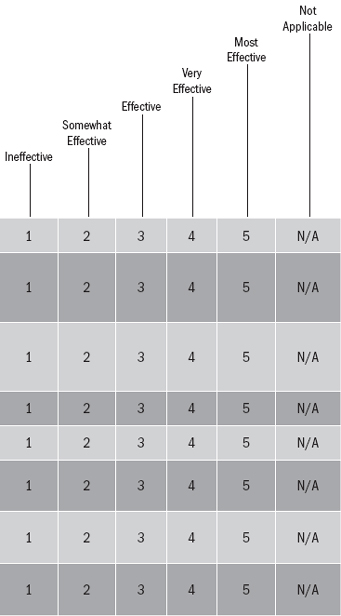
Please provide frank and specific feedback concerning this individual’s observable behaviors and your reactions to those behaviors.
Comments:
My colleague:
33. Displays an open and approachable style.
34. Communicates accurate information in a clear and timely manner.
35. Represents and articulates viewpoints in a way that positively influences communication.
36. Presents opinions accurately and persuasively, both one-on-one and to a group.
37. Finds common ground to accommodate conflicting needs/wants of different stakeholders.
38. Gives full attention to others when they are communicating and accurately processes what is said with a minimum of personal bias.
39. Provides honest, clear, and respectful feedback to others and voluntarily solicits feedback from others.
40. Responds to conflict with a problem-solving, nonblaming approach that produces successful outcomes.
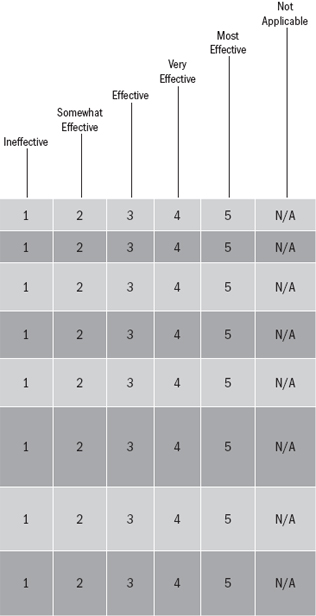
Please provide frank and specific feedback concerning this individual’s observable behaviors and your reactions to those behaviors.
Comments:
In team interactions, my colleague:
41. Knows (and applies) the competencies that truly differentiate success for all key roles before making important human resource decisions.
42. Recognizes that the human capital asset is the most important asset in the organization.
43. Utilizes a variety of selection/promotion tools (i.e., assessments, interviews, etc.) to accurately determine an individual’s capability for assuming a new role.
44. Connects quickly and consistently with individuals and the team to consider the work preferences, values, capabilities, and their engagement levels in order to make necessary adjustments as time goes on.
45. Accurately and effectively identifies the A, B, and C players based on performance, potential, and readiness.
46. Provides appropriate rewards and opportunity (i.e., recognition, money, promotions, etc.) based on relative performance, potential, and readiness to assume other roles.
47. Creates individual development plans that target both the strengths that need to be sustained and the development needs that each individual needs to focus on.
48. Provides targeted development (e.g., on-the-job experiences, coaching, and training programs) that enable individuals to become the best they can be.
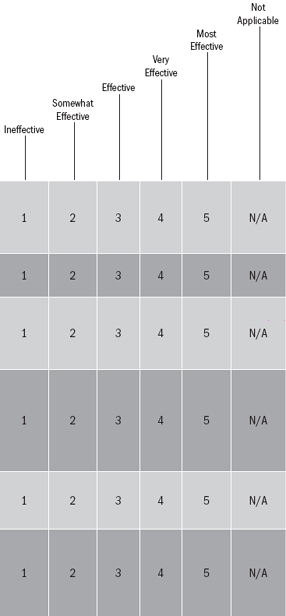
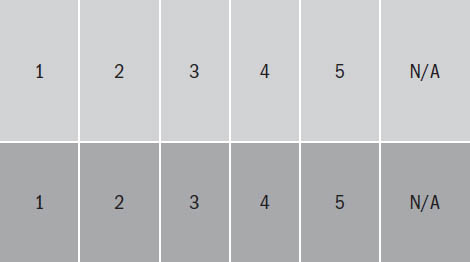
Please provide frank and specif feedback concerning this individual’s observable behaviors and your reactions to those behaviors.
Comments:
My colleague:
49. Demonstrates versatility while providing a consistent sense of direction for the team.
50. Develops a collaborative and inspiring team vision that is aligned with the mission, strategy, goals, and tactics.
51. Effectively structures the work to be accomplished, using structure and work flow, so that employees can perform their best without confusion or unnecessary obstacles.
52. Creates by word and action–a culture in which people feel valued and team members support one another.
53. Ensures that the customer is kept at the forefront, including establishing excellent relationships with vendors and suppliers.
54. Fosters a culture in which trust is the foundation for team success.
55. Fosters a culture in which team members can talk openly and honestly and conflict can emerge in an unfiltered way.
56. Creates a culture in which the team can commit to decisions–putting aside their differences–and hold each other accountable for results.
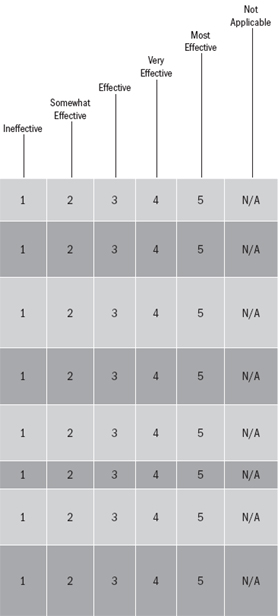
Please provide frank and specific feedback concerning this individual’s observable behaviors and your reactions to those behaviors.
Comments:
My colleague:
57. Convinces others of the need for change due to critical organizational objectives.
58. Provides an anchor for others in time of change by reaffirming key values and goals.
59. Perceives barriers to change and helps remedy them.
60. Works with others to create a common vision for change or team effectiveness rather than doing it independently.
61. Solicits input from others in resolving issues that impede change/team progress.
62. Clearly defines a clear vision and set of values that captures the essence of why change is required.
63. Effectively creates and implements a plan and process for achieving desired change.
64. Effectively leads and manages change while managing the day-to-day business/operations.
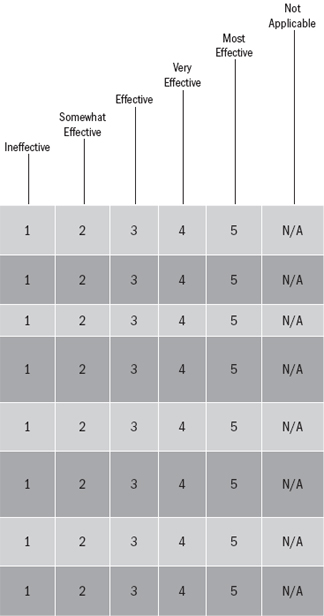
Please provide frank and specific feedback concerning this individual’s observable behaviors and your reactions to those behaviors.
Comments:
My colleague:
65. Is decisive in thought and action.
66. Strives to set and achieve ambitious goals rather than settling.
67. Overcomes potential stumbling blocks to achieve an objective.
68. Is passionate about doing what is required to achieve breakthrough results.
69. Shows energy and perseverance over the long term; is a marathoner.
70. Maintains discipline when disruptions might detract attention from key objectives.
71. When faced with limited resources, is able to focus on key objectives.
72. Is disciplined when attacking tough issues.
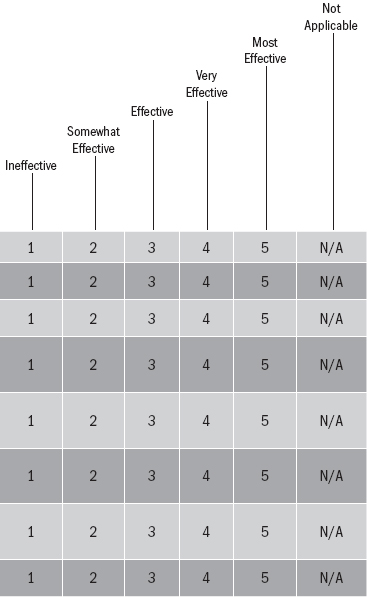
Please provide frank and specific feedback concerning this individual’s observable behaviors and your reactions to those behaviors.
Comments: